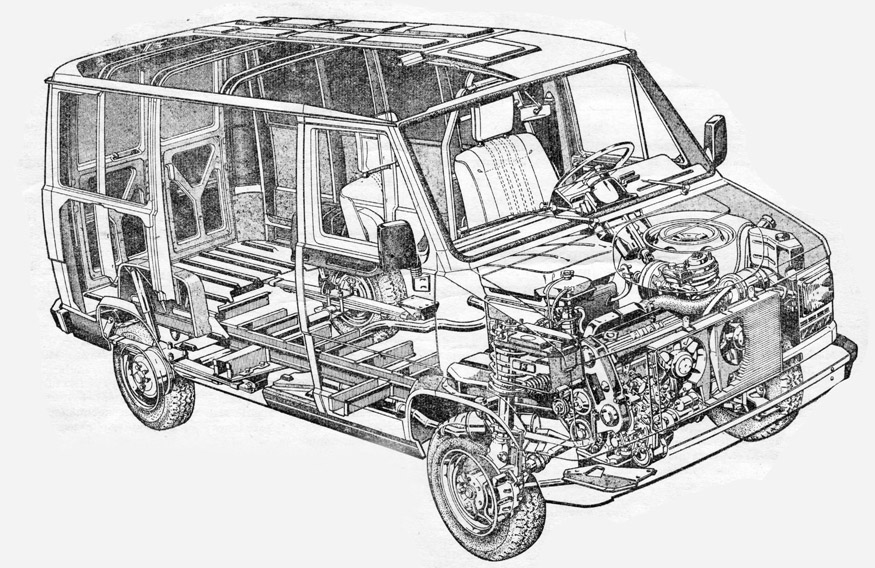 Vehicle family, although individual models were sold under different names, is based on a single design solution. The family is divided into two groups of vehicles:
Vehicle family, although individual models were sold under different names, is based on a single design solution. The family is divided into two groups of vehicles:
— type '1000' with payload 1070 kg and total weight 2450 kg,
— type '1300' with payload 1405 kg and total weight 2900 kg.
The construction of all vehicles is highly unified, the differences are in the use of different motors, gearboxes, tires and one of sixteen variants of the body. The basic variation is a self-supporting wagon adapted to two wheelbases. Further mutations are: minibus nine- or fifteen people, box truck, chassis with standard and extended cab. A cabin may have 2 the 3 places, it is "through" with a single tier floor, devoid of elements hindering the movement in the transverse direction and is distinguished by this, that it has a nearly flat front wall separating the cabin interior from the engine compartment. This solution enables good isolation of the cabin from the engine, ensuring low noise level and tightness. The cabin door is located behind the front wheels, which ensures comfortable and easy entry and exit. The engine was placed in a short, separate compartment in front of the front axle. There is a radiator in front of the engine with two electrically driven fans, and a spare wheel next to the engine. Positioning the spare wheel in the engine compartment helps to make use of the usable space.
The engine is located transversely on the right side of the engine compartment. On the extension of the crankshaft there is a clutch and gearbox interlocked with the main gear with spur gear. Drive torque is transmitted from the final drive to the front wheels via three-finger joints, driveshafts of equal length and constant velocity joints. The drive system is therefore a copy of the solutions found in many modern passenger cars. It is characterized by compactness and the absence of bevel gears in the main gear, if you omit the differential wheels.
The self-supporting body of the vehicle, in addition to the two front doors, has a double-wing rear door with a width 1314 mm and height 1372 mm. On request, the body can be equipped with sliding doors located on the right side of the car. The usable space has the following dimensions: length - 2680 mm, width - 1715 mm, width between wheel arches - 1220 mm, height - 1519 (1840) mm, volume - 6,5 (7,7) m3, ascent of the loading surface without load - 540 mm, with load - 442 mm.
The dimensions in parentheses apply to the high-roof variant. The length of the usable space of the elongated variety is 3410 mm.
Cars of the "1000" group are fitted with 4-speed gearboxes with a gear ratio 3,727 – 0,829, while in cars of the group "1300" 5-speed gearbox with a span 3,727-0,767. The rigid rear axle, made of a pipe with welded pins, is guided by two longitudinal springs. Independent McPherson front-wheel suspension and rack-and-pinion steering mechanism are designed in the same way as in new front-wheel drive passenger cars. The braking system consists of front disc brakes, rear drum, dual-circuit steering system with vacuum power steering and rear axle brake force limiter. Both groups of cars are equipped with 14-inch tires 165 X 14 the 185 X 14 - according to the load.
The cars had good dynamic properties (speed max. 120 – 124 km/h, acceleration time from 0 do 100 km / h is 35 – 45 s) .
A technical curiosity was the placement of the gear lever under the steering wheel. Such a solution, widely used in the sixties, later it was replaced by a lever located on the floor ensuring comfortable and precise gear shifting. Return of the gear lever to the steering wheel, in the car in question, it is justified on the same grounds. With the gearbox in the vicinity of the steering mechanism, the association of the two is logical. In addition, the removal of the gear lever from the floor was one of the measures aimed at ensuring the smoothness of the cabin.
The issue, which required considerable investment - especially in the field of technology - was to protect the vehicle against corrosion. As befits a car from the 1980s, the body is bonderized, phosphated, and the primer is applied by cataphoresis. Closed profiles are secured by injecting a special preparation, the main ingredient of which is wax. The durability of the profiles is additionally increased by the zinc sheet, from which they are made.